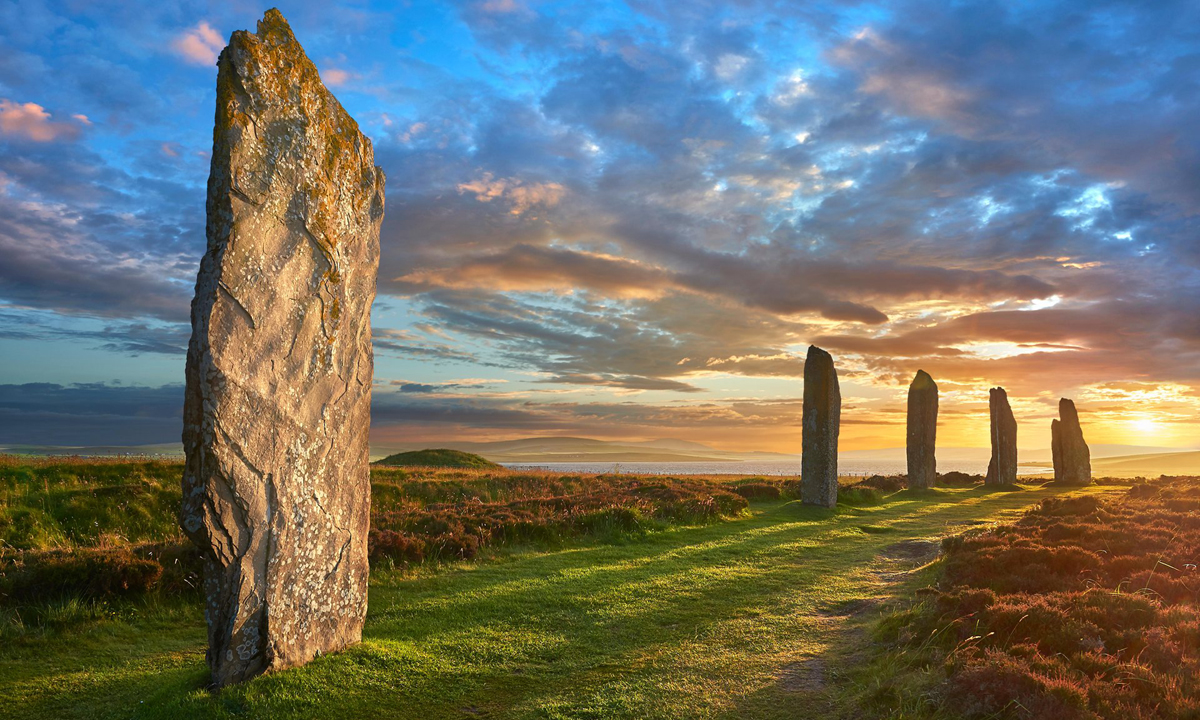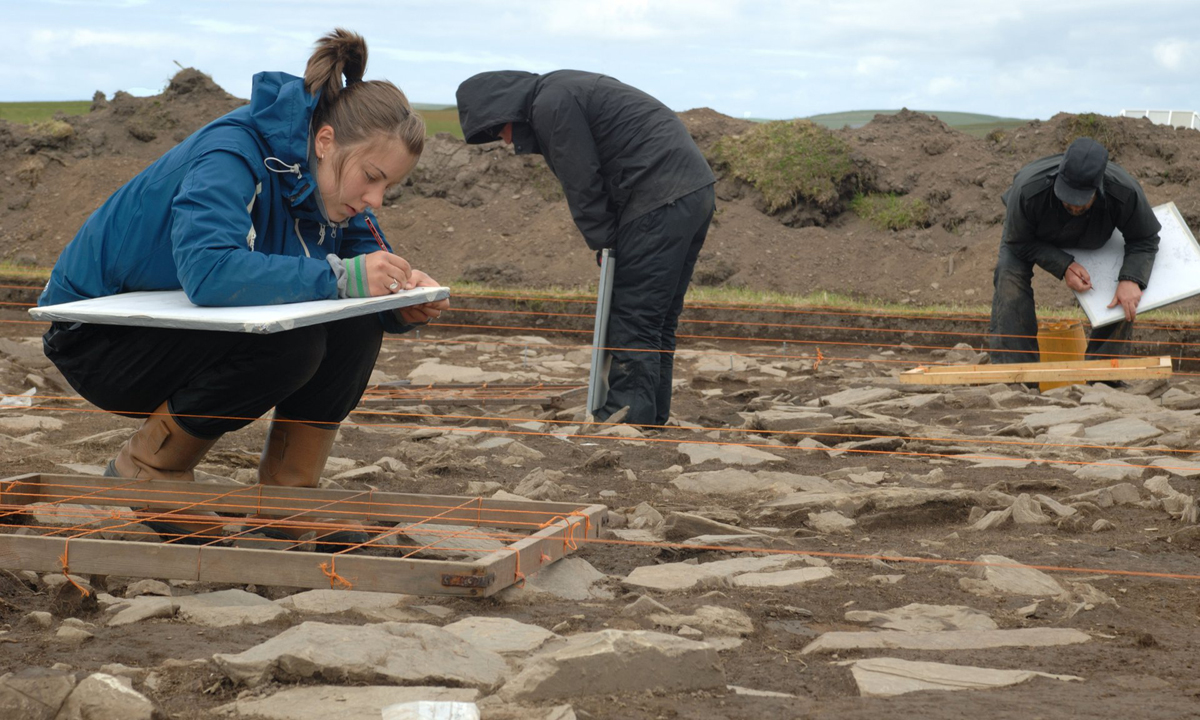


An article by Kevin McKenna on theguardian - From Orkney to the Fens, our ancient past is coming alive - reports on the exciting state of British archaeology: the Orkney Ness of Brodgar site is changing perceptions of neolithic man, and further south a bronze-age find is being hailed as 'Britain's Pompeii'. However, funds are tight.

The Ring of Brodgar. Image: Alamy
The Council for British Archaeology has designated the last two weeks in July as Britain's Festival of Archaeology, with hundreds of digs and visits being arranged all over Britain. The organisers couldn't have picked a better time for their festival. Some 650 miles south of Orkney, at Whittlesey in Cambridgeshire, archaeologists are still in the first stages of wonder at the extraordinary bronze age site of Must Farm. It seems that Britain is experiencing a golden age of archaeology fuelled by pioneering programmes such as Time Team and the adventures of Neil Oliver in programmes such as Coast and Vikings.
The Orkney Ness of Brodgar site - in March 2003 Nick Card and Professor Jane Downes, of the University of Highlands and Islands Archaeology Institute, and Julie Gibson, the county archaeologist, began work on the Ness of Brodgar, now seen as 'a sacred place that defined the passage of time'.
Britain's ancient past is coming alive #archaeology #Brodgar @MustFarm https://t.co/fRojcbbJCo pic.twitter.com/IywBMXnX6k
— Bradshaw Foundation (@BradshawFND) July 26, 2016
Bronze age socketed axe with a wooden handle unearthed at Must Farm Quarry, Whittlesey. Image: Dave Webb/Cambridge Archaeologic/PA
Over the 12 years work revealed one of the world's greatest neolithic finds: a complex settlement of buildings and structures made 4,500 years ago which is changing our understanding and perception of this era and its people. Amid the 21 structures made of fine-grained sandstone, a repository of art, pottery and other artefacts has been uncovered. The materials to construct this place were carried here over several miles from various parts of the islands, suggesting that these rooms and chambers were a dynamic meeting place where people came for trade and ceremonials. This settlement depicts a dynamic, skilled and creative people whose workmanship would bear scrutiny with 21st-century methods.
The Heart of Neolithic Orkney was officially recognised as a UNESCO World Heritage site in 1999 and includes Skara Brae, the Ring of Brodgar and the ethereal Maeshowe, an ancient burial chamber that is illuminated by the rays of the sun on the winter solstice.
The excavations going on at Ness of Brodgar and at Whittlesey do not come cheaply, though. They are all made possible by public support, the willingness of volunteers, and pockets here and there of public funding.

Archaeologists digging at the Ness of Brodgar on Orkney. Image: Alamy
The archaeology at Ness of Brodgar will not continue indefinitely. In a few seasons, they will back-fill their excavations and leave these buildings once more in the soil that entombed them for millennia. In time, another group of archaeologists may return, armed with instruments of a heightened technological specification, whereupon this mound might choose to reveal something more of itself.
The Ness of Brodgar dig continues with the kindness of the landowners whose acreage hosts these ruins. But Britain?s decision to leave the European Union is causing concern, as it is in scientific and academic communities up and down the country.
Card states that around 28% of scientific projects in this country are funded by EU money, but there has been no indication how that money will be replaced. "We are grateful for the £40,000 a year we get from Orkney council, but, like many other projects, we always look to other sources of funding as well. The Scottish government currently spends £1.2m a year on archaeology, which is the same as when Margaret Thatcher was in power. If we had found Skara Brae last week we would not have been able to excavate it."
Down at Must Farm in Cambridge, the archaeologists working on the 3,000-year-old bronze age settlement are experiencing the same thrill as their Ness of Brodgar counterparts. In its latest online diary entry there is an effusion: "Since the excavation began, almost every day has revealed new finds, discoveries and information about the late bronze age." Discoveries include textiles, boxes, wheels and axes - a 3,000-year-old late bronze age socketed axe with its haft still attached. The Must Farm settlement has one of the most complete bronze age assemblages ever discovered in Britain and it is giving us an unprecedented insight into the lives of the people there 3,000 years ago.
Other recent discoveries
Dozens of the earliest texts ever found in Britain, written by the Romans, were found earlier this year. They were inscribed on wooden tablets and found buried in waterlogged ground near St Paul's Cathedral. The tablets give accounts of life in London in the earliest years of the city's existence.
In May this year the remains of a medieval chapel which King Arthur is thought to have visited were uncovered after being lost for 50 years. A dig at Beckery Chapel near Glastonbury is expected to date the buildings accurately: the trenches will then be filled in and the position of the chapel marked on the ground.
A Roman villa was found in April underneath a garden near Tisbury in Wiltshire. Historic England confirmed that a mosaic found was part of the floor of a grand villa built between AD175 and 220.
The tomb of Richard III was discovered on the site of the former Greyfriars Church in Leicester in September 2012. It is now a car park.
Visit our British Isles Prehistory Archive:
http://www.bradshawfoundation.com/british_isles_prehistory_archive/index.php
Commentby Bradshaw Foundation
Monday 04 December 2023
by Bradshaw Foundation
Friday 30 June 2023
by Bradshaw Foundation
Thursday 06 April 2023
by Bradshaw Foundation
Thursday 24 November 2022
by Bradshaw Foundation
Tuesday 27 September 2022
by Bradshaw Foundation
Thursday 08 September 2022
by Bradshaw Foundation
Tuesday 19 July 2022
by Bradshaw Foundation
Monday 06 June 2022
by Bradshaw Foundation
Friday 11 March 2022
by Bradshaw Foundation
Wednesday 02 March 2022
by Bradshaw Foundation
Thursday 26 August 2021
by Bradshaw Foundation
Monday 16 August 2021
by Bradshaw Foundation
Tuesday 06 July 2021
by Bradshaw Foundation
Thursday 06 May 2021
by Bradshaw Foundation
Thursday 06 May 2021
by Bradshaw Foundation
Tuesday 16 March 2021
by Bradshaw Foundation
Monday 04 December 2023
by Bradshaw Foundation
Friday 30 June 2023
by Bradshaw Foundation
Thursday 06 April 2023
by Bradshaw Foundation
Thursday 24 November 2022
by Bradshaw Foundation
Tuesday 27 September 2022
by Bradshaw Foundation
Thursday 08 September 2022
by Bradshaw Foundation
Tuesday 19 July 2022
by Bradshaw Foundation
Monday 06 June 2022
by Bradshaw Foundation
Friday 11 March 2022
by Bradshaw Foundation
Wednesday 02 March 2022
by Bradshaw Foundation
Thursday 26 August 2021
by Bradshaw Foundation
Monday 16 August 2021
by Bradshaw Foundation
Tuesday 06 July 2021
by Bradshaw Foundation
Thursday 06 May 2021
by Bradshaw Foundation
Thursday 06 May 2021
by Bradshaw Foundation
Tuesday 16 March 2021
Friend of the Foundation











